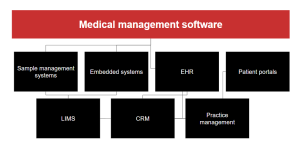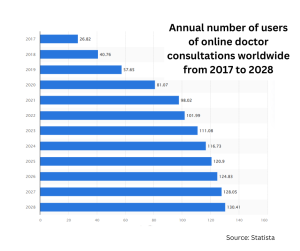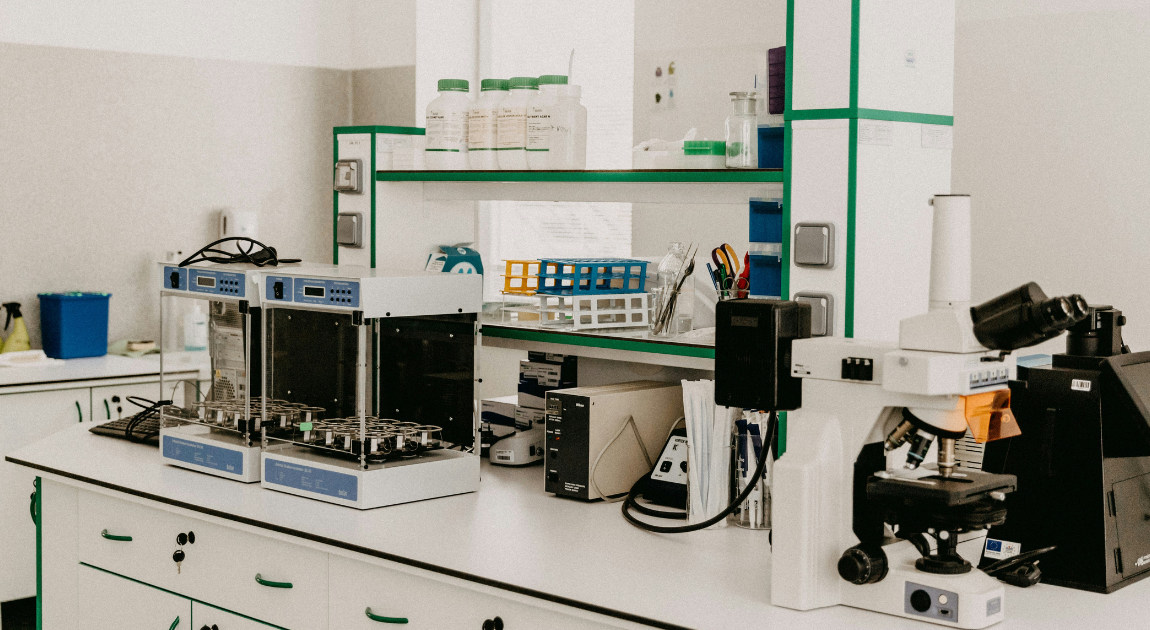What are the leading trends in clinical laboratory management software? While there are countless systems (and startups developing such systems), is there a way to create an actual holistic infrastructure to take care of all the aspects of the process? It turns out, no one has really implemented a 360-degree platform, but the key is not in putting everything under a single hood. Rather, it’s about achieving interconnection with a clear view of what exactly you want the infrastructure as a whole to do, and a focus on what you define as a priority. In this article, we’re exploring the basic elements of what makes up the medical laboratory management software development market.
Why medical lab management software matters
Reluctant as the industry may seem (to an outsider) to embrace technology, this is actually an illusion. At least in the first-world countries (and since “first world” as a term is kinda outdated, many other countries are known to lead the way in separate digitalization niches). The reason is simple: medical laboratory management software systems enable labs to handle the increasing workload without compromising on the quality of service – and this is directly linked to the proportion of people demanding adequate medical care and viewing it as a personally paid-for asset. According to a report by Grand View Research, the global laboratory informatics market size is expected to reach USD 3.8 billion by 2025, indicating the growing reliance on digital management tools.
Boiled down, the essence of medical lab management software lies in its ability to integrate and streamline various aspects of laboratory operations: from relevant logistics to financial and legal aspects all the way down to patient centricity and actual treatment based on the lab results. The Centers for Disease Control and Prevention estimates that 7 billion tests are performed in US labs alone every year, which means a colossal amount of data to manage. Software tools aid in automating tasks such as sample tracking, data entry, and result analysis. This reduces manual errors – which can be as high as 0.1% according to recent studies – a seemingly small percentage that translates into a significant number of mismanaged tests given the volume.
Types of medical laboratory management software and what they can do
Medical laboratories are increasingly leveraging technology to streamline operations and improve patient care. At the heart of this transformation is, of course, medical laboratory management software, seeing as how it’s specifically designed to optimize various facets of laboratory operations. Here’s a look at some of the primary types of medical laboratory management software and their capabilities:
Sample Management Systems
Sample management systems are specialized tools designed to track and manage biological samples within the laboratory. These systems allow for meticulous recording of sample details, including type, origin, and storage conditions, providing an essential audit trail from receipt through to processing and disposal. This traceability is critical for maintaining the integrity of laboratory results and ensuring compliance with regulatory standards. By automating sample tracking, laboratories can minimize errors, improve throughput, and ensure the reliability of diagnostic information.
EHR Software
Electronic Health Records (EHR) software is pivotal in the digitalization of patient information, offering a comprehensive and integrated view of a patient’s medical history. EHR systems facilitate seamless communication between laboratories and other healthcare departments, allowing for the swift exchange of test orders and results. This interoperability is crucial for ensuring timely and coordinated patient care, reducing the risk of errors associated with manual data entry, and promoting a more patient-centric approach to healthcare.
Embedded Medical Systems
Embedded medical systems refer to software solutions that are integrated into medical devices or laboratory instruments. These systems enable automated data capture directly from the equipment, ensuring precise and real-time recording of test results. This automation not only boosts productivity but also enhances the reliability of data by eliminating manual input errors. Embedded systems play a crucial role in modern laboratories, supporting complex analyses and enabling high-throughput testing with minimal human intervention.

Medical Practice Management Software
Medical practice management software is designed to streamline the administrative and financial aspects of running a medical laboratory or healthcare facility. This type of software manages patient billing, appointment scheduling, insurance claims, and revenue cycle management. By optimizing these operational processes, medical practice management software can significantly reduce administrative burden, improve cash flow, and allow healthcare providers to focus more on patient care rather than paperwork.
Healthcare CRM
Healthcare Customer Relationship Management (CRM) systems specifically cater to the needs of the healthcare sector by managing interactions with patients and other stakeholders. These platforms support marketing efforts, patient engagement initiatives, and service improvements by leveraging data analytics. A healthcare CRM can personalize the patient experience, improve communication strategies, and foster loyalty by addressing patients’ needs more effectively. This is particularly important in a competitive healthcare market where patient satisfaction is increasingly linked to business success.
The essential features in clinical laboratory management software
The right software can significantly improve workflows, reduce errors, and enhance patient care. Here’s a detailed examination of the essential features that clinical laboratory management software must possess:
LIMS (Laboratory Information Management Systems)
LIMS form the backbone of any modern laboratory’s digital infrastructure, offering a robust framework for managing all laboratory operations. According to MarketsandMarkets, the global LIMS market is projected to reach USD 1.7 billion by 2025, growing at a CAGR of 12.6% from 2020. This growth is driven by the need for increased efficiency, compliance with stringent regulation, and the integration of laboratory systems with healthcare networks. LIMS enables the automation of workflows, integration with instruments, and management of data throughout its lifecycle, making them indispensable in the modern lab.
Document Management
With the volume of documentation handled by clinical laboratories, including test results, reports, and compliance records, an integrated document management system is crucial. Such a system ensures documents are securely stored, easily retrievable, and maintained in compliance with regulatory standards. Effective document management reduces the risk of errors and improves operational efficiency, which is vital in an environment where a single missed document can have serious implications.
Sample Tracking and Management
Efficient sample tracking and management are critical, given that an estimated 0.1% of laboratory tests involve some form of sample identification error, according to a study published by the National Center for Biotechnology Information. Sample management features enable laboratories to track the status of each sample in real time, from collection to analysis and storage, minimizing the risk of mix-ups or losses and ensuring the integrity of test results.
Insurance Processing
With the intricate web of insurance policies and billing requirements, streamlined insurance processing capabilities within laboratory management software can significantly reduce administrative burdens and improve cash flow. Automated insurance verification, claims processing, and reconciliation features help labs navigate the complexities of billing with greater accuracy, leading to fewer denied claims and faster reimbursement.
Compliant Data Sharing
In the era of digital health, the ability to share laboratory data securely and in compliance with regulations such as HIPAA in the US, or GDPR in Europe, is non-negotiable. Compliant data sharing features ensure that patient data is protected during transmission, accessible only by authorized personnel, and handled according to the relevant legal frameworks. This capability not only supports interoperability across the healthcare continuum but also upholds patient privacy and trust.
Inventory Management
Efficient inventory management is vital for maintaining the smooth operation of a clinical laboratory. An estimated 20% of a laboratory’s budget can be tied up in inventory costs, according to the American Society for Clinical Laboratory Science. Features that enable real-time tracking of reagents, consumables, and other inventory items can help labs prevent shortages, reduce waste, and control costs effectively.
e-Prescribing
e-Prescribing systems enhance the usability of laboratory management software by enabling healthcare providers to send prescriptions directly to pharmacies electronically. This feature reduces the risk of prescription errors, which affect approximately 1.5 million people annually in the United States alone, as reported by the Institute of Medicine. Moreover, it streamlines the medication dispensing process, improving patient convenience and treatment adherence.
Patient Portals
Patient portals represent a direct link between laboratories and patients, offering a platform for secure communication, access to test results, and the management of appointments. According to a survey by the Medical Group Management Association, 90% of healthcare leaders recognized patient portal technology as a priority for patient engagement strategies. Portals empower patients by giving them control over their health information and facilitating active participation in their own care.
Challenges in clinical laboratory management software
There’s somewhat of a dilemma: if it wasn’t for patient centricity and data protection imperatives, many types of this software would have developed along more or less the same lines as logistics software. On the other hand, it’s exactly the attention to the fact that one is dealing with humans that drives the industry through the challenges and makes the software into what it’s supposed to be.
This means the way to excellence lies in overcoming exactly these challenges, and while there are countless startups offering “bitesize” solutions, if you’re determined to build a unique system, these need to be addressed as the first order of business.
#1 Data Security and Privacy
Data breaches are becoming all too common, with a reported increase of 55% in healthcare data breaches in 2020 compared to the previous year, according to the HIPAA Journal. Clinical laboratories handle sensitive patient information daily, making them prime targets for cyber-attacks. Ensuring the integrity and security of this data within a laboratory management system requires robust encryption, regular security audits, and adherence to global data protection regulations. The challenge lies in maintaining a fortress-like security posture without impeding the accessibility and usability of the system for authorized users.
#2 Integrations
For clinical laboratory management software to truly enhance laboratory operations, it must seamlessly integrate with a variety of other systems and instruments within the healthcare ecosystem. This includes electronic health records (EHR), patient management systems, billing and insurance platforms, and the myriad of specialized laboratory instruments. Additionally, there’s a growing need for integrations with patient-facing software, including appointment scheduling. Achieving such interoperability can be daunting due to the diverse and often proprietary nature of these systems.
#3 Correspondence to Actual Workflows
Anyone who’s either working in a lab themselves or has a friend who is, knows the workflows can vary to a crazy extent. As an example, in our team alone, five people have experienced tick bites in the past 2 months, went to different labs to test for Lyme disease, and experienced very different timelines and procedures. A significant challenge is customizing the management software to fit these specific workflows, rather than forcing changes to established, efficient practices. In some cases, customization options may be limited, requiring laboratories to adapt their operations to the software. Finding a balance between customization and usability, while maintaining the integrity of laboratory processes, demands both flexibility and innovation from software providers.
#4 ROI Recovery
The implementation of clinical laboratory management software represents a considerable investment for many laboratories, not just in terms of financial outlay but also time and resources dedicated to training and adoption. The challenge lies in realizing a return on investment (ROI) in a timely manner. Factors such as improved efficiency, reduced error rates, and enhanced compliance contribute to ROI, but these benefits can take time to materialize. Additionally, the constant evolution of technology necessitates ongoing updates and possibly further investment, complicating ROI calculations.

Current trends
The landscape of healthcare is constantly evolving, propelled by technological advancements and changing patient expectations. This dynamic environment has given rise to several key trends in laboratory management software and medical software at large.
The surge in telehealth is undeniably one of the most transformative trends of the past few years, with the global telehealth market expected to reach USD 559.52 billion by 2027, according to a report by Fortune Business Insights. This surge is not only a response to the COVID-19 pandemic but also to the growing demand for accessible and convenient healthcare services. Laboratory management and medical software platforms are increasingly incorporating telehealth functionalities, enabling remote patient consultations, virtual monitoring, and direct communication between patients and healthcare providers. This integration enhances patient engagement and allows for more proactive and preventive healthcare management.
On the other hand, precision medicine, with its focus on tailoring medical treatments to individual characteristics, behaviors, and genetic makeup, is significantly impacting laboratory management and medical software. Systems are now being developed to handle vast datasets, integrating and analyzing genetic, environmental, and lifestyle factors to support personalized treatment plans. This requires advanced analytics and data management capabilities, pushing laboratory and medical software towards greater sophistication in data handling and interpretation. As precision medicine continues to advance, the demand for software that can support complex, personalized data analysis will grow.
Point-of-Care testing is changing the landscape of diagnostics by bringing tests closer to the patient, often at the patient’s bedside, in a pharmacy, or even at home. This shift towards decentralized testing is facilitated by advancements in laboratory management software that can integrate with portable diagnostic devices, delivering rapid results directly into the hands of healthcare providers. PoC testing relies heavily on connectivity, data management, and real-time analysis features within medical software, enhancing the ability to make quick, informed decisions. This trend not only improves patient outcomes but also increases the efficiency of healthcare delivery.
Optimizing the medical supply chain, from pharmaceuticals to laboratory reagents, is crucial for the operational efficiency of healthcare institutions. Medical logistics, as a trend, focuses on the application of advanced tracking, predictive analytics, and inventory management within laboratory management and medical software to ensure that the right resources are in the right place at the right time. Moreover, with the global push towards sustainability, software solutions are increasingly incorporating features that enable the efficient use of resources, reduction of waste, and minimization of the carbon footprint of healthcare operations.
Interoperability: what other medical software is a factor?
An additional hurdle to overcome is that even if you have a perfectly functioning system to solve a particular problem (e.g. cataloging samples, or storing analysis data), it will still need to be integrated at least somewhat into the other systems. Two pivotal areas that benefit from enhanced interoperability are scheduling systems and patient-facing portals, both of which are integral components of the healthcare experience.
Scheduling systems are the backbone of healthcare logistics, ensuring that patients are seen by the right healthcare providers at the right times. Interoperability in scheduling systems allows for seamless communication between different healthcare providers’ systems, laboratory management software, patient portals, and electronic health record (EHR) systems. This integration enables:
- Automated Appointment Setting: Patients can have real-time access to the availability of doctors across multiple facilities and book appointments directly, reducing administrative burdens and wait times.
- Appointment Reminders and Updates: Automated notifications can be sent to patients through various channels, such as SMS or email, minimizing the number of missed appointments and enhancing patient engagement.
- Resource Optimization: Healthcare facilities can optimize the utilization of their resources, including consultation rooms, equipment, and practitioners’ time, leading to more efficient operations.
At the same time, patient-facing portals are a good investment option: online platforms that give patients access to their medical records, test results, educational information, and enable communication with healthcare providers. Interoperability with these portals extends beyond providing access to static information, encompassing:
- Engagement and Management: Patients can manage their health more proactively by scheduling appointments, requesting prescription refills, or communicating with their healthcare providers directly through the portal.
- Personal Health Record (PHR) Integration: By ensuring that patient-facing portals can interoperate with a variety of EHR systems and health apps, patients can compile a comprehensive and cohesive view of their health history, medication, and treatments.
The interoperability of patient-facing portals and scheduling systems with other medical software leads to a more connected, efficient, and patient-centered healthcare ecosystem. Patients enjoy a more seamless healthcare experience, with easier access to their information and services, while healthcare providers benefit from the efficiency and accuracy that integrated systems provide.
Conclusions
The future of clinical laboratory management software is not about creating a singular, all-encompassing platform but rather about achieving seamless interconnectivity among specialized systems. By focusing on interoperability, patient-centricity, and regulatory compliance, laboratories can harness the power of technology to streamline operations, reduce errors, and ultimately improve patient care. The trends towards telehealth, precision medicine, and point-of-care testing, combined with the need for efficient medical logistics, underscore the importance of sophisticated and integrated software solutions. As laboratories navigate these evolving demands, partnering with a specialized software development agency can be the key to implementing systems that not only meet current needs but are also scalable for future advancements.
Lionwood is dedicated to developing customized, cutting-edge solutions that enhance efficiency and ensure compliance with industry standards. Contact our experts today to discuss how we can help you build a robust, interconnected infrastructure tailored to your specific needs.













